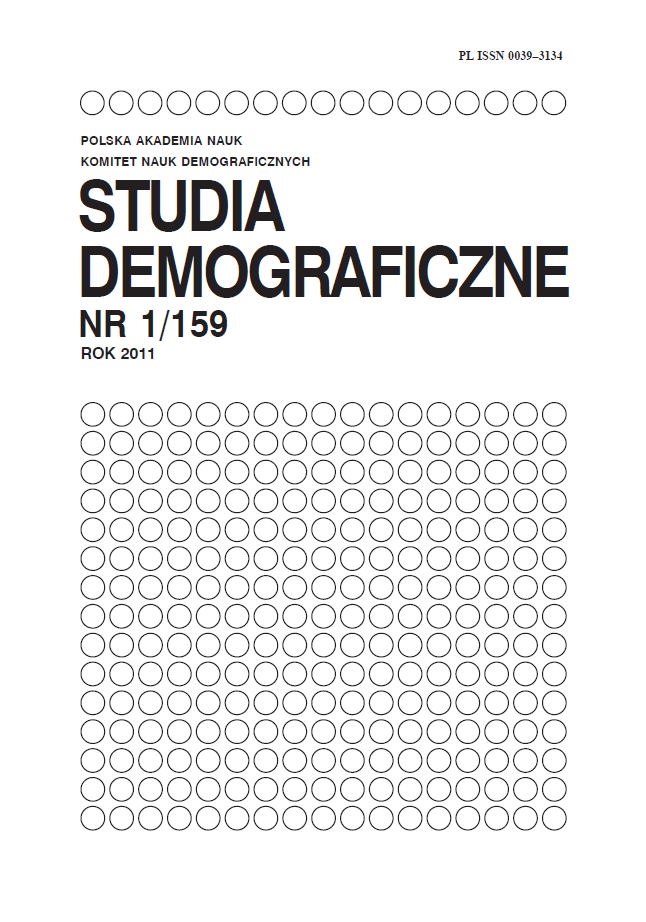The female-male gap in life expectancy in Poland
Main Article Content
Abstract
The difference in life expectancy between the sexes in Poland started to decline only in 1991, equaling 8.4 years in 2009. In addition, with the rapid increase in male excess mortality between 1989 and 1991, the sex gap also increased. With the exception of excess mortality of male infants, the female advantage in mortality grows with age and reaches the maximum at the age of 65–70 years in 2009. The excess mortality of male infants decreased over the studied years from a contribution of over a year to the sex gap in life expectancy at birth in 1959, to less than a month in 2009. Differences in life expectancy at birth between the sexes in Poland are greater in rural than in urban areas and there is a variation between the voivodships: from 7.9 years in 2008 in the Pomorskie voivodship to 10.2 years in Lubelskie. The largest variation in the sex gap in life expectancy was that between different educational groups: and the gap decreased with the level of educational attainment.
Diseases of the circulatory system are a major group of causes of death, with the highest contribution to the sex gap in life expectancy, and were the largest factor in the narrowing of the sex gap between 1991 and 2006. External causes of death were the second-largest group contributing to the sex gap in life expectancy at birth in 1991, and to the narrowing of the gap in the studied period. Over the years under study, the importance of malignant neoplasms for the phenomenon in consideration increased, but at the same time life expectancy of both sexes rose due to improvements in mortality from this group of causes.
According to our estimates, smoking- and alcohol-related causes of death together explained about 50% of the total difference in life expectancy at birth between the sexes in the years 1989–2006. In this period, the sex gap in life expectancy due to these causes of death increased, which is opposite to what was reported for other developed countries.
Article Details
References
[2] Barford A., Dorling D., Smith M., Shaw G.D., 2006, Life expectancy: Women now on top everywhere, „British Medical Journal”, vol. 332, no. 7545, 808.
[3] Case, A., Paxson C., 2005, Sex differences in morbidity and mortality, „Demography”, vol. 42, no. 2, 189–214.
[4] Christensen K., Orstavik K.H., Vaupel J.W., 2001, The X chromosome and the female survival advantage. an example of the intersection between genetics, epidemiology and demography. [in:] M. Weinstein, A.I. Hermalin, M.A. Stoto (eds.), Population Health and Aging. Strengthening the Dialogue Between Epidemiology and Demography, The New York Academy of Sciences, New York, 175–183.
[5] Drevenstedt G.L., Crimmins E.M., Vasunilashorn S., Finch C.E., 2008, The rise and fall of excess male infant mortality, Proceedings of the National Academy of Sciences, vol. 105, no. 13, 5016–5021.
[6] Eurostat, 2011, Demographic Balance and Crude Rates 1960–2010, http://epp.eurostat.ec.europa.eu/portal/page/portal/population/data/database (data downloaded on 01.04.2011).
[7] Giovino G.A., 2002, Epidemiology of Tobacco Use in the United States, „Oncogene”, vol. 21, no. 48, 7326–7340.
[8] Giovino G.A., Henningfield J.E., Tomar S.L., Escobedo L.G., Slade J., 1995, Epidemiology of Tobacco Use and Dependence, „Epidemiologic Reviews”, vol. 17, no. 1, 48–65.
[9] Glei D.A., Horiuchi S., 2007, The narrowing sex differential in life expectancy in high-income populations: Effects of differences in the age pattern of mortality, „Population Studies”, vol. 61, no. 2, 141–159.
[10] Główny Urząd Statystyczny, 1992, Rocznik Demograficzny, Główny Urząd Statystyczny, Warszawa.
[11] Główny Urząd Statystyczny, 2010, Rocznik Demograficzny, Główny Urząd Statystyczny, Warszawa.
[12] Harris J.E., 1983, Cigarette smoking among successive birth cohorts of men and women in the United States during 1900–80, „Journal of the National Cancer Institute”, vol. 71, no. 3, 473–479.
[13] Human Mortality Database, 2011, University of California, Berkeley, USA, and Max Planck Institute for Demographic Research, Germany, Available at www.mortality.org (data downloaded on 03.04.2011).
[14] McCartney G., Mahmood L., Leyland A.H., Batty G.D., 2011, Contribution of smoking-related and alcohol-related deaths to the gender gap in mortality: Evidence from 30 European countries, „Tobacco Control”, vol. 20, no. 2, 166–168.
[15] Meslé F., 2004, Mortality in Central and Eastern Europe: Long-term trends and recent upturns. „Demographic Research”, Special Collection 2, Article 3, 43–70.
[16] Nathanson C.A., 1984, Sex differences in mortality, „Annual Review of Sociology”, vol. 10, 191–213.
[17] Pampel F.C., 2002, Cigarette Use and the Narrowing Sex Differential in Mortality, „Population and Development Review”, vol. 28, no. 1, 77–104.
[18] Preston S.H., Heuveline P., Guillot M., 2001, Demography: Measuring and Modelling Population Processes, Blackwell Publishers, Oxford.
[19] Preston S.H., Wang H., 2006, Sex mortality differences in the United States: The role of cohort smoking patterns, „Demography”, vol. 43, no. 4, 631–646.
[20] Roeters van Lennep J.E., Westerveld H.T., Erkelens D.W., van der Wall E., 2002, Risk factors for coronary heart disease: Implications of gender, „Cardiovascular Research”, vol. 53, no. 3, 538–549.
[21] Seely S., 1990, The gender gap: Why do women live longer than men?, „International Journal of Cardiology”, vol. 29, no. 2, 113–119.
[22] Vallin J., Caselli G., Surault P., 2006, Mortality, sex, and gender, [in:] G. Caselli, J. Vallin, and G. Wunsch (eds.), Demography. Analysis and Synthesis. A Treatise in Population Studies, Volume II, Elsevier Academic Press, Amsterdam, 177–194.
[23] Wingard D.L., 1984, The sex differential in morbidity, mortality, and lifestyle, „Annual Review of Public Health”, vol. 5, 433–458.
[24] Wojtyniak B., Stokwiszewski J., Goryłski P., Poznałska A., 2008, Długość życia i umieralność ludności Polski, [in:] B. Wojtyniak, P. Goryłski (eds.), Sytuacja Zdrowotna Ludności Polski. Narodowy Instytut Zdrowia Publicznego, Warszawa, 31–87.
[25] Wróblewska W., 2006, Analiza umieralności w Polsce w latach 1970–2003. Dekompozycja zmian w oczekiwanym trwaniu życia noworodka, „Studia Demograficzne”, no. 1/149, 28–48.
[26] World Health Organization, 2011, Health statistics and health information systems, www.who.int/healthinfo/en/, (data downloaded on 03.04.2011).
